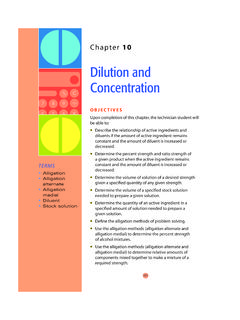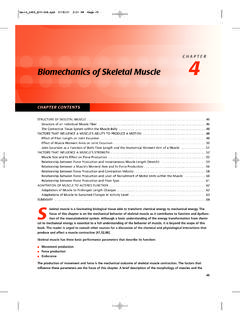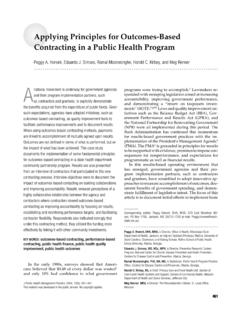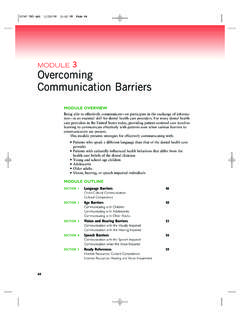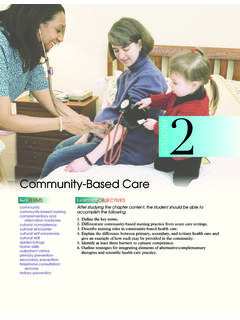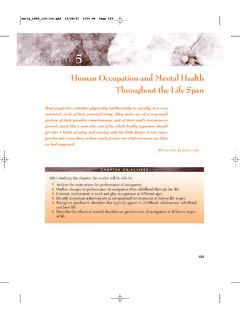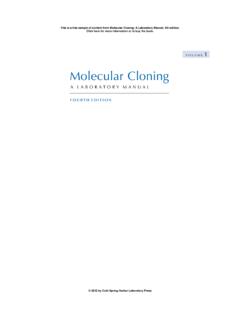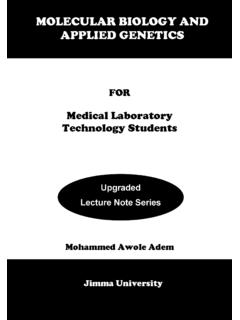Transcription of THE Rh BLOOD GROUP SYSTEM - Lippincott Williams & …
1 139 CHAPTER10139 THE Rh BLOOD GROUP SYSTEMCONNIE WESTHOFFThe Rh BLOOD GROUP SYSTEM is one of the mostpolymorphic and antigenic BLOOD GROUP sys-tems. It is second only to ABO in importance inblood transfusion and is well known as a primarycause of hemolytic disease of the fetus and newborn(HDFN). The principal antigen is D, and the termsRh positiveand Rh negativerefer to the presence orabsence of D antigen. Caucasians of European ex-traction have the highest incidence of the Rh-nega-tive phenotype (15% to 17%), and Rh-negative typeis much less common in Africa (5%) and Australiaand is considered a rare BLOOD type not routinelytested for in some parts of Asia ( 1%). Other com-mon Rh antigens include the antithetical C and c,and E and e antigens. Patients are not routinelytyped for these unless they have developed atypicalantibodies or are facing long-term transfusion sup-port for diseases such as myelodysplasia or sicklecell disease (SCD).
2 In addition to the five principalantigens (D, C, c, E, and e), more than 50 other Rhsystem antigens are known. Because they are notoften encountered in the routine BLOOD bank, theywill not be covered here in detail. References at theend of the chapter provide further information forinterested genes RHDand RHCE encode the Rh proteins:one encodes the D antigen and the other encodes CEantigens in various combinations (ce, cE, Ce, or CE)OBJECTIVESA fter completion of this chapter, the reader will be able the Rh SYSTEM antigens, alleles inherited at each causes of weak D and partial D in C and e antigen to determine an individual s most causes of the Rh SYSTEM antibody reactivity and the administration of Rh immune the reagents used in Rh typing and the appropriate causes of discrepancies in Rh WORDSC ompound antigenDeleted or partially deletedphenotypeFisher and RaceG antigenISBTP artial DRh haplotypeRh immune globulinRh negativeRh positiveRhnullWeak DWiener 11/11/09 6:16 PM Page 139(Fig.)
3 10-1). The RhD and RhCE proteins encoded bythe two genes differ by 32 to 35 amino acids. This contrasts with most BLOOD GROUP SYSTEM antigens thatare encoded by single genes, with alleles that differ byonly one or a few amino acids. Most D-negative (Rh-negative) phenotypes are the result of complete dele-tion of the RHDgene. The large number of amino aciddifferences between RhD and RhCE proteins explainswhy RhD is so antigenic when encountered by the im-mune SYSTEM of someone who is Rh negative and hasonly RHCE gene encodes C and c antigens, whichdiffer by four amino acids: Cys16 Trp (cysteine atresidue 16 replaced by tryptophan) encoded by exon 1,and Ile60 Leu, Ser68 Asn, and Ser103 Pro encoded inexon 2. E and e differ by one amino acid, Pro226 Alaencoded in exon 5 (Fig. 10-1).
4 NOMENCLATUREThe Rh SYSTEM was discovered in the 1940s, and several terminologies developed over the years. Thesereflected differences in thinking regarding the inheri-tance of the antigens. Fisher and Racebelieved thatthe Rh SYSTEM consisted of three closely linked genesor alleles: D at one locus, C or c at the second, and E ore at the third, as reflected in the DCE terminology(Table 10-1). This terminology is used most often inwritten discussions of the Rh SYSTEM antigens. TheWiener terminologywas based on the belief that theRh antigens were the products of a single gene codingfor an agglutinogen composed of multiple bloodfactors. The names given to each of the five major Rh antigens were Rh0, rh , rh , hr , and hr , but theoriginal Wiener terminology is obsolete.
5 A modified140 UNIT 4 Red BLOOD Cell Groups and HLA123456789101234567891012345678910G+G+ G+G+G+G+c+e+C+e+C+E+c+E+CecECEceC16W, I60L, S68N, S103PC16W, I60L, S68N, S103P A226PA226 PBARC antigen------------deleted------------R0 R1R2 RZRHDRHCED negative (Rh negative)Hybrid gene - Partial DVIFIGURE 10-1RH genes. Diagram of the RHDand RHCE genes indicating the changes associated with the com-mon antigen polymorphisms, the haplotypes (R0, etc.), and an example of a hybrid gene encoding partial DVI. The10 coding exons of the RHDgene are shown as white boxesand the 10 exons of RHCEare shown as red boxes. Theamino acid changes associated with the common antigens are indicated by single-letter designations and the posi-tion in the protein . For example, an E+ RBC phenotype results when alanine (A) at amino acid position 226 ischanged to proline (P), which is encoded in exon 5 of RHCE.
6 The c+ versus C+ phenotype is associated withchanges also encoded byRHD(white box). The shared exon 2 of RHDand RHCE explains the expression of G antigen (G+) on RhCe and RhD proteins. Most Rh negatives (D negatives) are due to deletion of the of one of the gene rearrangements between RHDand RHCE that results in a partial D phenotype, as wellas a new Rh antigen, 11/11/09 6:16 PM Page 140 CHAPTER 10 The Rh BLOOD GROUP System141 TABLE 10-1Rh Nomenclature and Incidence of Common HaplotypesIncidence (%)Fisher-RaceModified WienerHaplotypeHaplotypeCaucasianAfrican BlackAsianRh positiveDceR1421770 DcER2141121 DceR04443 DCERz< < negativeCer37263 Cer 222 CEr 1 < (Table 10-1) is useful in spoken language toconvey the Rh haplotype. Uppercase R is used to de-scribe haplotypes that produce D antigen, and lower-case r (or little r) is used when D is absent.
7 The C or cand E or e Rh antigens carried with D are representedby 1 for Ce (R1), 2 for cE (R2), 0 for ce (R0), and z for CE(Rz) (Table 10-1). The symbols prime ( ) and doubleprime ( ) are used with r to designate the CcEe anti-gens; for example, prime is used for Ce (r ), doubleprime for cE (r ), and y for CE (ry). The R versus rterminology allows one to convey the common Rhantigens present on one chromosome in a single term(a phenotype). Dashes are used to represent missingantigens of the rare deletion (or CE-depleted) pheno-types; for example, D (referred to as D dash, dash)lacks C/c and E/e Society of BLOOD Transfusion(ISBT)terminology assigns each antigen a example, D is Rh1, C is Rh2, E is Rh3, c is Rh4,and e is Rh5, and so on. The presence or absence ofeach antigen on the red BLOOD cell (RBC) is noted bythe designation Rh:1 for the presence of D andRh: 1 for the absence of D, and so forth.
8 An RBCthat is nonreactive for D, C, and E, but positive forc and e would be designated as Rh: 1, 2, 3, 4, terminology is difficult for oral communica-tion, but it is precise for manuscript and computerusage, although it has not gained widespread Rh terminology distinguishes betweenthe antigens, genes, and proteins. The antigens are referred to by the letter designations, D, C, c, E, and RH genes are designated by capital letters, withor without italics, and include erythroid RHD, RHCE,and RHAG. The alleles are designated by the gene fol-lowed by an asterisk (*); for example, alleles of theRHCE gene are designated RHCE*ce, RHCE*Ce,RHCE*cE, and so on, according to which antigensthey encode. The proteins are indicated as RhD,RhCE, or according to the specific antigens they carry,Rhce, RhCe, RhcE, or Probable GenotypeTyping RBCs for the five major Rh antigens yields theRBC phenotype.
9 The probable genotype coding forthe phenotype can be deduced from gene frequencyestimates. This is useful when a person is multiplytransfused or when typing a father to determine theprobability that a fetus may suffer from hemolytic dis-ease when the mother has an Rh antibody. The preva-lence of Rh haplotypes by ethnic GROUP is shown inTable 10-1. Knowledge of ethnicity is important whendetermining the most probable genotype. As an exam-ple, if the RBCs phenotype D C c E e and thepatient is European American, the most probablegenotype would be Dce/ce (R0r); however, if the pa-tient is African American, Dce/Dce (R0R0) would bemore likely because the occurrence of the R0haplo-type is higher (44%) than that of the r haplotype (26%)in African Americans. More accurate determination ofthe RH genotype, specifically RHDzygosity, is ofsignificance when the mother has anti-D.
10 11/11/09 6:16 PM Page 141groups. Lastly, position effects can also influence Dantigen expression. This occurs when a Ce allele isfound intransto RHDand the amount of D antigen inthe membrane is reduced. Samples that exhibit thisphenomenon have an R1r (DCe/Ce), R0r (Dce/Ce), orR2r (DcE/Ce) for Weak DTesting the RBCs for weak D is not required for patients, unless typing the RBCs of an infant to deter-mine if an Rh-negative mother is a candidate for Rhimmune globulin. Weak D testing is also sometimesperformed on the Rh-negative mother before the deliv-ery of the infant if the facility uses microscopic readingof the weak D test, or a rosetting test with anti-D, to de-tect large D fetal maternal bleed after delivery. Test-ing for weak D in an apparent D-negative patientneeding large-volume or long-term transfusion couldconserve the use of D BLOOD for weak D is required by the AABB Stan-dards for BLOOD Banks and Transfusion Servicesfor donorunits, and the unit must be labeled Rh positive if thetest is positive.

